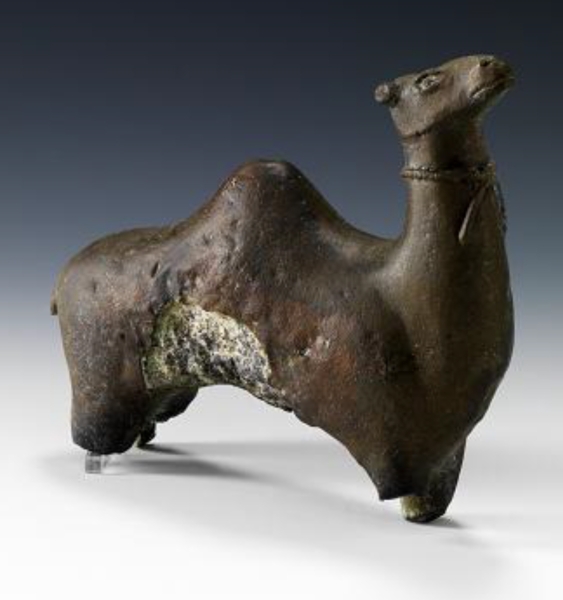
The Bronze Camel Figurine is one of the archaeological artifacts selected to participate in the Saudi Archeological Masterpieces Through the Ages Exhibition, held at the Louvre Museum in the French capital, Paris, in 2010. The exhibition featured three hundred pieces of varied materials and eras, original artifacts from different regions of the Kingdom of Saudi Arabia, classified according to their historical sequence into three groups: Pieces from the prehistoric ages, pieces from the pre-Islamic period, and pieces from the Islamic eras.
Description of the figurine
The figurine is a camel made of bronze; only the base of its tail remains, along with a small portion of its arms and legs. It dates back between the third century BCE and the third century CE, and it belongs to the civilization of al-Faw. The camel features a forward, small hump that appears like a mountain or hill, a narrow abdomen, and a huge neck that is massive in its lower part and delicate in its upper part. Its head is small, with oval eyes in which the pupil is depicted defiantly, and it has two small ears. Next to the junction of the head and neck, there is a circular band as if tied at the front of the neck.
Dimensions of the figurine
Length: Twenty-one cm.
Height: Seventeen cm.
History of the figurine
The bronze camel figurine was found in the archaeological Qaryat al-Faw, where a civilization once flourished and maintained close ties with other civilizations. Qaryat al-Faw is located southeast of Wadi ad-Dawasir Governorate, Riyadh Province, Saudi Arabia.
Registered under number 36 Q 11, the bronze camel figurine is preserved at the Museum of the Archaeology Department at King Saud University in Riyadh, and it was included as part of a selected group in the Saudi Archeological Masterpieces Through the Ages Exhibition, which encompassed artifacts related to Saudi heritage in the social, cultural, and economic fields.
The discovery of the bronze camel is considered one of the outcomes of the archaeological survey and excavation work conducted by the antiquities and museums sector in Saudi Arabia over recent years, as part of the efforts of Saudi archaeologists, scientific missions, and specialized research teams.
Significance of the figurine
The appearance of the camel in various forms and materials demonstrates its importance in pre-Islamic Arab societies as a source of food, a primary means of transportation used by the Arabs in their travels, and a carrier of incense and spices, which contributed to their prosperity.
Related quizzes
Related articles

